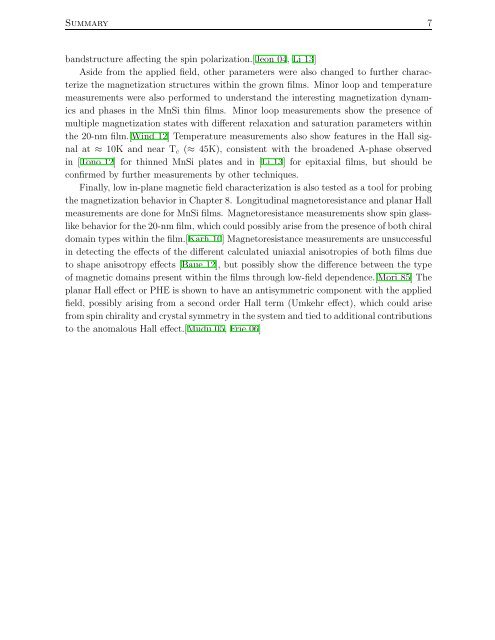As and Epitaxial-Growth MnSi Thin Films - OPUS Würzburg
As and Epitaxial-Growth MnSi Thin Films - OPUS Würzburg
As and Epitaxial-Growth MnSi Thin Films - OPUS Würzburg
You also want an ePaper? Increase the reach of your titles
YUMPU automatically turns print PDFs into web optimized ePapers that Google loves.
Summary 7<br />
b<strong>and</strong>structure affecting the spin polarization.[Jeon 04, Li 13]<br />
<strong>As</strong>ide from the applied field, other parameters were also changed to further characterize<br />
the magnetization structures within the grown films. Minor loop <strong>and</strong> temperature<br />
measurements were also performed to underst<strong>and</strong> the interesting magnetization dynamics<br />
<strong>and</strong> phases in the <strong>MnSi</strong> thin films. Minor loop measurements show the presence of<br />
multiple magnetization states with different relaxation <strong>and</strong> saturation parameters within<br />
the 20-nm film.[Wind 12] Temperature measurements also show features in the Hall signal<br />
at ≈ 10K <strong>and</strong> near T c (≈ 45K), consistent with the broadened A-phase observed<br />
in [Tono 12] for thinned <strong>MnSi</strong> plates <strong>and</strong> in [Li 13] for epitaxial films, but should be<br />
confirmed by further measurements by other techniques.<br />
Finally, low in-plane magnetic field characterization is also tested as a tool for probing<br />
themagnetizationbehaviorinChapter8. Longitudinalmagnetoresistance <strong>and</strong>planarHall<br />
measurements are done for <strong>MnSi</strong> films. Magnetoresistance measurements show spin glasslikebehaviorforthe20-nmfilm,<br />
whichcouldpossiblyarisefromthepresenceofbothchiral<br />
domain types within the film.[Karh 10] Magnetoresistance measurements are unsuccessful<br />
in detecting the effects of the different calculated uniaxial anisotropies of both films due<br />
to shape anisotropy effects [Baue 12], but possibly show the difference between the type<br />
of magnetic domains present within the films through low-field dependence.[Mori 85] The<br />
planar Hall effect or PHE is shown to have an antisymmetric component with the applied<br />
field, possibly arising from a second order Hall term (Umkehr effect), which could arise<br />
fromspinchirality<strong>and</strong>crystalsymmetryinthesystem<strong>and</strong>tiedtoadditionalcontributions<br />
to the anomalous Hall effect.[Mudu 05, Frie 06]
















